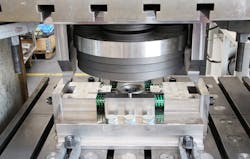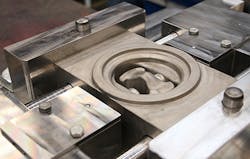Improving manufacturing processes frequently is not the result of extensive, coordinated research, but of the insights the emerge incidentally in such efforts. Germany’s Institut für Integrierte Produktion Hannover gGmbH (an industrial research and consulting center) has previously focused its energy and resources on researching, developing, and improving a multidirectional forging process for automotive pistons in steel, which have design and performance advantages in fuel-efficient engines.
In the course of developing and refining multidirectional forging, IPH developed an innovative tool suitable for hot forging complex geometries that had not previously been feasible.
The group introduced the tool in 2017.
Using the multidirectional forging process that IPH developed, it is possible to produce undercuts – for instance, pin bores in steel pistons. Forging undercuts makes the subsequent machining of the pistons more efficient and effective, saves material, and reduces production costs. This makes the use of forged steel pistons more profitable and the parts more reliable.
Conventional forging tools are not well suited to create the undercuts because of the difficulty of removing the part from the tool after the forging sequence is completed.
Undercuts are areas or protrusions that are perpendicular to the forming direction. In the example of the pin bore in steel pistons for combustion engines, it is a feature that generally has had to be created by drilling after forging.
Forging undercuts makes the subsequent machining of steel pistons more efficient and effective, saves material, and reduces production costs.
With the new tool developed at IPH, bores can be pre-formed during the forging process. The tool disposes of two horizontally driven sliders. When the die moves down, the sliders are driven horizontally into the hot steel billet, thus forming the area for the pin bore, i.e., the undercut. When the die moves up again, the sliders are driven back, and the forged part can be removed from the tool.
Forging undercuts simplifies subsequent machining considerably, speeding up the manufacturing process and reducing the overall costs. Moreover, about 5% less material is needed to form the piston, and so less energy is consumed during the forming process when the pin bores are pre-formed during forging.
Thus, with the availability of the IPH-developed tool, steel pistons can be produced much more quickly and at lower cost.
Also, according to IPH, the new forging approach may increase part quality because the cutting process interrupts the grain flow, but bulk metal forming makes use of it. As a consequence, forming the pin bores during hot forging reduces the appearance of unwanted notch effects. And, according to the researchers, this will make the piston more reliable.
The tool was developed at IPH in cooperation with industrial partners in connection with its development of multidirectional forming over nearly 20 years.
In crankshaft production, multidirectional forging has already been refined and scaled up to manufacturing standards. Within the scope of the “Forging Undercuts” project, the researchers’ focus was primarily on high-strength steel pistons, as used in small, fuel-efficient turbo engines. However, they note that the principle can easily be transferred to other components.
About the Author
Robert Brooks
Editor/Content Director - Endeavor Business Media
Robert Brooks has been a business-to-business reporter, writer, editor, and columnist for more than 20 years, specializing in the primary metal and basic manufacturing industries. His work has covered a wide range of topics including process technology, resource development, material selection, product design, workforce development, and industrial market strategies, among others.
Currently, he specializes in subjects related to metal component and product design, development, and manufacturing—including castings, forgings, machined parts, and fabrications.
Brooks is a graduate of Kenyon College (B.A. English, Political Science) and Emory University (M.A. English.)


